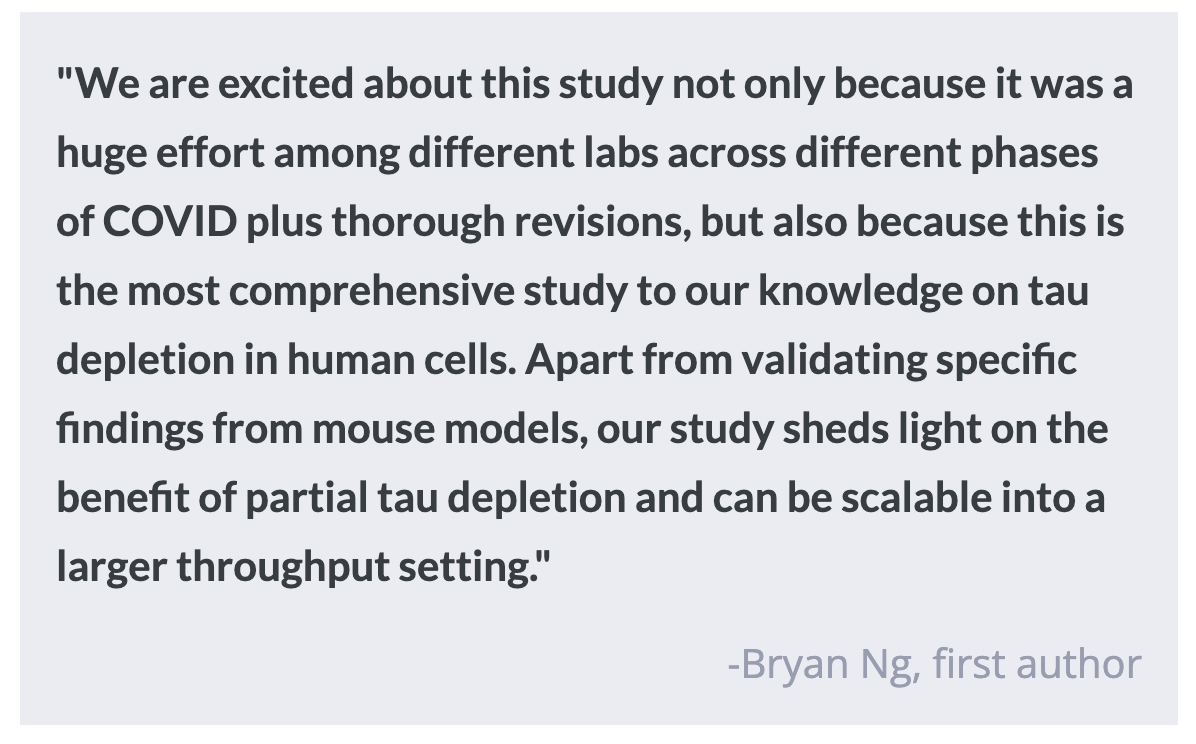Tau Protein in Human Neurons is Essential for Amyloid Beta-Driven Toxicity in Alzheimer’s Disease
Post by Laura Maile
The takeaway
Amyloid beta and tau are two proteins that aggregate in the brain of patients with Alzheimer’s Disease and are linked to the degeneration of neurons and symptoms of the disease. When tau is depleted in human neurons, hyperactivity and neurodegeneration caused by amyloid beta is reduced.
What's the science?
Alzheimer’s Disease (AD) is characterized by the buildup of plaques and tangles, which are aggregates of amyloid beta and tau proteins, among other pathologies. One of the prominent theories of the primary cause of AD, the “amyloid hypothesis,” states that the buildup of amyloid beta leads to toxicity of neurons and neurodegeneration. Though the physical pathology of the disease has been well-described, scientists do not yet fully understand the interplay between amyloid beta, tau, and neurodegeneration, especially in human experimental models. Mouse models with tau genetically knocked out have shown that amyloid beta toxicity is dependent on tau. This week in Molecular Psychiatry, Ng and colleagues used gene-edited human cells to deplete tau and examine its role in amyloid beta-driven toxicity.
How did they do it?
The authors used Crispr-Cas9 to genetically modify the gene for tau in human induced pluripotent stem cells (hIPSCs). hIPSCs are generated using human cells that are induced back into being stem cells and then differentiated into specific cell types, such as neurons. Using this method, the authors could disrupt the tau gene in human cells. They confirmed that they had effectively depleted the tau transcript and protein in the cortical neurons generated from hIPSCs. They first examined the effects of tau depletion on neuronal activity, using electrodes to measure extracellular field potentials. Using the same methods, they measured neural activity over time in cells treated with homogenate from post-mortem AD brain tissue. To determine the specific effects of amyloid beta on synapse loss seen in AD, they extracted amyloid beta from post-mortem brains of AD patients and treated neurons both with and without tau. They then examined the effects on synapse loss using immunocytochemistry to label synaptic markers. Next, the authors investigated the effect of tau loss on the movement of mitochondria down axons by plating the hIPSC-derived neurons on one side of a chamber and live imaging the movement of mitochondria. This was followed by a similar experiment where they added amyloid beta oligomers to the neurons to mimic a toxic amyloid beta insult, and monitored mitochondrial movement. Finally, they tested whether the depletion of tau could protect against neurodegeneration caused by amyloid beta. To do this, they again used amyloid beta oligomers to provide a toxic insult to hIPSC-derived cortical neurons with and without tau, and compared cell death in each set of neurons.
What did they find?
The authors discovered that cortical neurons with the tau protein depleted showed reduced neuronal activity. Neurons with tau that were treated with homogenate from the brains of AD patients showed hyperactivity over time, but both neurons without tau and neurons treated with an amyloid beta blocker were protected from this hyperactivity. This means that the hyperactivity observed was caused by amyloid beta and was dependent on tau. Treatment with amyloid beta from AD brains leads to synapse loss in normal neurons, but not in tau-deficient neurons, meaning that tau is essential for amyloid beta-induced synapse loss. When normal neurons were treated with amyloid beta, axonal transport of mitochondria was reduced. This effect was reversed in neurons missing tau, while the movement of mitochondria was not changed in cells missing tau that had not been treated with amyloid beta. This suggests that the dysfunction in mitochondrial transport caused by amyloid beta is dependent on tau. When regular hIPSC-derived cortical neurons were treated with amyloid beta, cell death increased. Partial and full depletion of tau reduced this amyloid beta-driven neurodegeneration, suggesting that even partial reduction of tau can prevent cell death.
What's the impact?
This study found that amyloid beta-driven neuronal hyperactivity, synapse loss, axonal transport dysfunction, and neurodegeneration are dependent on tau in human cells. This suggests the continued importance of generating treatments to decrease tau in patients with AD.


